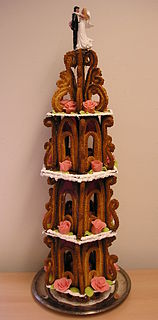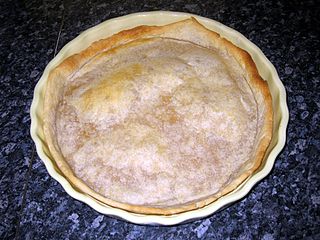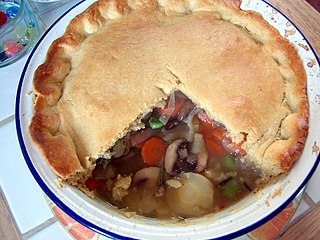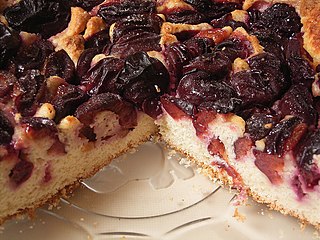
Dessert is a course that concludes a meal. The course consists of sweet foods, such as confections, and possibly a beverage such as dessert wine and liqueur. In some parts of the world, such as much of Central Africa and West Africa, and most parts of China, there is no tradition of a dessert course to conclude a meal.

Confectionery is the art of making confections, which are food items that are rich in sugar and carbohydrates. Exact definitions are difficult. In general, however, confectionery is divided into two broad and somewhat overlapping categories: bakers' confections and sugar confections. The occupation of confectioner encompasses the categories of cooking performed by both the French patissier and the confiseur.

Shortcrust pastry is a type of pastry often used for the base of a tart, quiche or pie. Shortcrust pastry can be used to make both sweet and savory pies such as apple pie, quiche, lemon meringue or chicken pie.

Pastry is a dough of flour, water and shortening that may be savoury or sweetened. Sweetened pastries are often described as bakers' confectionery. The word "pastries" suggests many kinds of baked products made from ingredients such as flour, sugar, milk, butter, shortening, baking powder, and eggs. Small tarts and other sweet baked products are called pastries. Common pastry dishes include pies, tarts, quiches, croissants, and pasties.

A pie is a baked dish which is usually made of a pastry dough casing that contains a filling of various sweet or savoury ingredients. Sweet pies may be filled with fruit, nuts, brown sugar, sweetened vegetables, or with thicker fillings based on eggs and dairy. Savoury pies may be filled with meat, eggs and cheese (quiche) or a mixture of meat and vegetables.

An apple pie is a pie in which the principal filling ingredient is apples. The earliest printed recipe is from England. Apple pie is often served with whipped cream, ice cream, or cheddar cheese. It is generally double-crusted, with pastry both above and below the filling; the upper crust may be solid or latticed. The bottom crust may be baked separately ("blind") to prevent it from getting soggy. Deep-dish apple pie often has a top crust only. Tarte Tatin is baked with the crust on top, but served with it on the bottom.

Cheesecake is a sweet dessert consisting of one or more layers. The main, and thickest, layer consists of a mixture of a soft, fresh cheese, eggs, and sugar. If there is a bottom layer, it most often consists of a crust or base made from crushed cookies, graham crackers, pastry, or sometimes sponge cake. Cheesecake may be baked or unbaked.

A Bakewell tart is an English confection consisting of a shortcrust pastry shell beneath layers of jam, frangipane, and a topping of flaked almonds. It is a variant of the Bakewell pudding, closely associated with the town of Bakewell in Derbyshire.

Apple crisp is a dessert made with a streusel topping. An apple crumble is a dessert of baked chopped apples topped with rolled oats and brown sugar. In the UK, Australia, and New Zealand, the term 'crumble' refers to both desserts, but in the US the two are distinguished. In Canada, both terms are used ambiguously.

Fruit curd is a dessert spread and topping usually made with citrus fruit, such as lemon, lime, orange, grapefruit or tangerine. Other flavor variations include passion fruit, mango, and berries such as raspberries, cranberries or blackberries. The basic ingredients are beaten egg yolks, sugar, fruit juice, and zest, which are gently cooked together until thick and then allowed to cool, forming a soft, smooth, flavorful spread. The egg yolks are usually tempered in the cooking process to prevent their coagulation. Some recipes also include egg whites or butter.

Woolton pie is a pastry dish of vegetables, widely served in Britain in the Second World War when rationing and shortages made other dishes hard to prepare. It was created at the Savoy Hotel in London by its then Maitre Chef de Cuisine, Francis Latry, and was one of a number of recipes commended to the British public by the Ministry of Food to enable a nutritious diet to be maintained despite shortages and rationing of food, especially meat. It was named after Frederick Marquis, 1st Earl of Woolton (1883–1964), who popularised the recipe after he became Minister of Food in 1940.

A lemon tart is a dessert dish, a variety of tart. It has a pastry shell with a lemon flavored filling.

Plum cake refers to a wide range of cakes made with either dried fruit or with fresh fruit. There is a wide range of popular plum cakes and puddings. Since the meaning of the word "plum" has changed over time, many items referred to as plum cakes and popular in England since at least the eighteenth century have now become known as fruitcake. The English variety of plum cake also exists on the European mainland, but may vary in ingredients and consistency. Settlers in British colonies brought the dried fruit variety of cake with them, so that for example, in India it was served around the time of the Christmas holiday season and in the American colonies, where it became associated with elections, one version came to be called "election cake".












